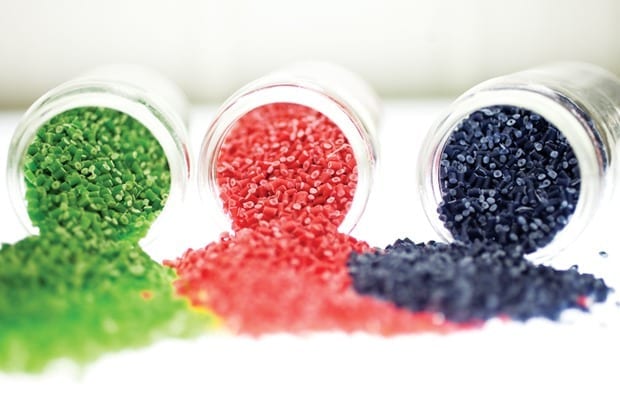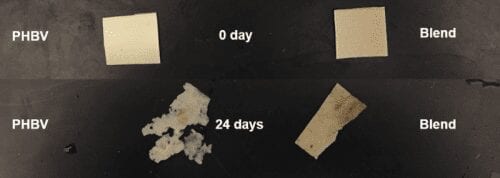
Researchers have developed a new way to use plant oils like olive and linseed oil to create polyurethane, a plastic material used in everything from foam insulation panels to tires, hoses and sealants.
The researchers, led by Michael Kessler, Berry Family director and professor in Washington State University’s School of Mechanical and Materials Engineering, have published a paper (http://pubs.acs.org/doi/pdf/10.1021/am5071333) on the work in the journal ACS Applied Materials & Interfaces (http://pubs.acs.org/journal/aamick).
Polyurethane is extremely tough and corrosion- and wear-resistant, but researchers would like a more environmentally friendly alternative to the petroleum-based product. About 14 million tons of polyurethane was produced in 2010, and production is expected to increase by almost 30 percent by 2016.
While there are already some polyurethanes made from plant materials, Kessler’s research group developed a new method that uses vegetable oils to create materials with a wide variety of flexibility, stiffness and shapes. Plant oils are inexpensive, readily available, renewable and can be genetically engineered.
In the study, the researchers made polyurethane using olive, canola, grape seed, linseed and castor oils. While other researchers have struggled with using petroleum-based solvents, the WSU researchers, working with colleagues from Iowa State and from Cairo universities, didn’t use solvents or a catalyst in their production.
To make polyurethane, manufacturers combine two types of chemical compounds in a reaction. One of the chemicals is a polyol, which is a compound with multiple hydroxyl functional groups that are available for reaction.
Some oils, like linseed oil, have five or six reactive sites, making the material stiffer. Others, such as olive oil, have fewer reactive sites, making the material more flexible.
“What’s new about this is specifically the way we make the polyols,” said Kessler, who compared the process to building with Legos. “It is the same concept with these chemical groups. They click together and form a chemical bond.
“The novelty of this particular work is that these polyurethanes are using a new chemistry made by a combination of castor oil fatty acid and modified vegetable oils,” he said.
Read more: Researchers use plant oils for novel bio-based plastics
The Latest on: Bioplastics
[google_news title=”” keyword=”Bioplastics” num_posts=”10″ blurb_length=”0″ show_thumb=”left”]
via Google News
The Latest on: Bioplastics
- Nissei says 'inclusive growth' covers recycling, bioplastics, energy savingson May 9, 2024 at 4:54 am
San Antonio, Texas-based Nissei America Inc. is introducing new injection molding technology to reduce environmental loads while simplifying processes.
- Bioplastic and Biopolymer: A Sustainable Solution with Lucrative Potential – Market to Reach USD 98 Billion by 2034on May 9, 2024 at 2:33 am
The bioplastic and biopolymer market is anticipated to reach a valuation of USD 16.8 billion in 2024. The industry is projected to be worth USD 98 billion by 2034, expanding at a CAGR of 19.3% between ...
- Customer demand sparks AgroRenew's accelerated constructionon May 8, 2024 at 9:00 pm
AgroRenew will build stage three of their bioplastics facility at the same time as the stage one and stage two projects after customers have ordered 100% of the ...
- Revolutionizing the Automotive Industry: Bioplastics Market Set to Soar to US$ 2,103.28 million by 2033on May 8, 2024 at 7:02 am
The global automotive bioplastics market value is likely to jump from US$ 761.06 million in 2023 to US$ 2,103.28 million by 2033. This estimated growth is expected to be driven by a CAGR of 10.7% in ...
- Green products key for An Phat Bioplastics to dominate market: chairmanon May 8, 2024 at 12:24 am
An Phat Bioplastics JSC, listed on the Ho Chi Minh Stock Exchange (HoSE) as AAA and a subsidiary of Hanoi-headquartered An Phat Holdings, will focus on researching and developing new products to ...
- Bioplastics News Streamon May 7, 2024 at 5:00 pm
One of the most dynamic categories in plastics is for bioplastics aka biopolymers and related bio-based materials made from renewable sources. The articles PlasticsToday publishes related to this high ...
- Should Bioplastics Be Allowed in Organic Compost?on April 29, 2024 at 7:14 am
The USDA will decide if synthetic, biodegradable food packaging and service ware should be allowed as a feedstock in certified organic compost.
- Bioplastics Market To Reach USD 64.2 Billion By 2032 | DataHorizzon Researchon April 28, 2024 at 8:30 pm
Demand for sustainability and alternatives drives the demand for bioplastics in the coming years. The growing importance of sustainability and circular economy is a major factor promoting market ...
- Ohio Hemp Company Re-Greening The Rust Belt With Bioplastics Option For Midwest Auto Industryon April 22, 2024 at 4:27 pm
The Ohio Hemp Company has formalized a partnership with Heartland Industries, based in Michigan, to cultivate hemp fiber destined for the burgeoning bioplastics market.
- Bioplastics as toxic as regular plastics; both need regulation, say researcherson April 22, 2024 at 12:57 pm
As negotiators meet this week for the fourth round of global plastics treaty talks, scientists warn that both plant-based and petroleum-based plastics are toxic, with both needing tough regulation to ...
via Bing News










